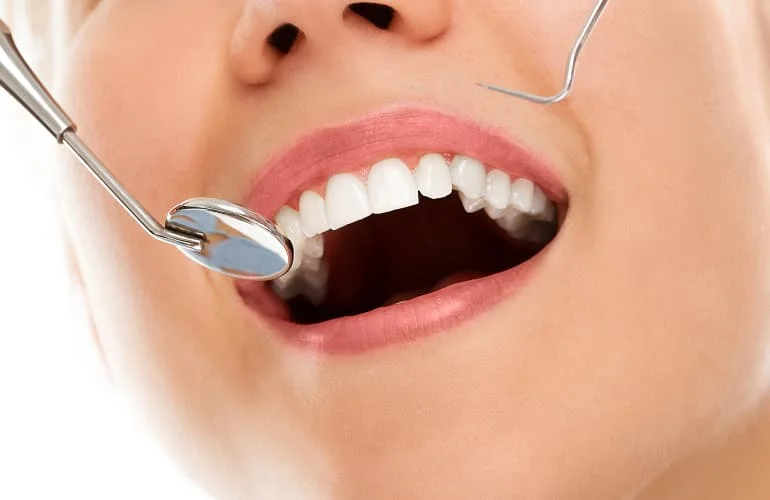The question of what bonding application is has become very common today. Bonding dental treatment is a frequently preferred method in aesthetic dentistry that delivers impressive results in a short time. This method is especially used to fix small fractures, discolorations, or gaps in the teeth. With bonding, it is possible to achieve a whiter, straighter, and more attractive smile in just a few hours. Combining aesthetics and functionality, this treatment easily and effectively conceals imperfections in your smile while boosting your confidence.
What Does Bonding Mean?
Bonding is a popular and minimally invasive treatment method in dentistry used to correct aesthetic problems. It is an aesthetic treatment applied to the surface of the natural tooth using a special material called composite bonding. This material is supported by a fiber bonding system to ensure perfect compatibility with the tooth.
What Is Bonding Dental Treatment?
What is Bonding? Bonding is a treatment method that allows correcting surface imperfections without damaging the natural structure of the tooth. Dental bonding is a quick and painless procedure, making it an easy and comfortable treatment process for patients. Bonding is frequently preferred for minor deformities in teeth, surface stains, or other aesthetic concerns.
During the procedure, a special resin material is applied to the tooth, which creates a perfect integration with the tooth. This makes it quite easy to achieve a natural appearance.
How Is Bonding Dental Treatment Done?Bonding Diş Tedavisi Nasıl Yapılır?
Color Selection:
First, the dentist selects the composite resin shade that best matches the natural color of your teeth. This ensures the treatment result looks natural.
Tooth Preparation:
The surface of the tooth is lightly roughened, which allows the bonding material to adhere better. At this stage, anesthesia is usually not required, as there is no pain or discomfort during the procedure.
Bonding Application:
Next, an adhesive material is applied to the surface of the tooth. This helps the composite resin bond securely to the tooth.
Composite Resin Application:
The composite resin in the selected shade is applied to the tooth. The resin is shaped to match the natural tooth structure. The dentist’s skill is very important at this stage, as the goal is to achieve an aesthetic result.
Curing:
After the composite resin is applied, the dentist uses a special ultraviolet light to harden the material. This ensures the resin bonds firmly to the tooth and gains long-term durability.
Shaping and Polishing:
Finally, finishing touches are made so that the dental bonding material takes on a shape harmonious with the other teeth. The treatment is completed by polishing the tooth, resulting in a finish that matches the shine of natural teeth.
Compared to other restorative dental treatments, bonding is generally faster and requires less removal of tooth material. However, composite resin may be less durable than porcelain veneers or crowns, so regular dental check-ups and good oral hygiene are essential.
Who Is Bonding Dental Treatment Suitable For?
Tooth bonding, or teeth bonding treatment, is an ideal solution especially for individuals with aesthetic concerns who want to quickly correct certain imperfections in their teeth. What Problems Can Bonding Dental Treatment Solve?
Tooth Discoloration:
Bonding can be applied when slight changes in tooth shade are needed, for example, to cover discoloration or stains on the teeth.
Gaps Between Teeth:
Bonding treatment is often preferred to close small gaps between teeth, particularly the front ones. Applying bonding to gapped teeth is a commonly used method that delivers beautiful results.
Chipped or Cracked Teeth:
Bonding is performed using composite resin to repair areas where the tooth is chipped or cracked.
Imperfections in Tooth Shape:
If there are shape, length, or size irregularities in the tooth that cause aesthetic concerns, bonding can be used to correct these imperfections.
Protection of Teeth:
When the root of the tooth is exposed due to gum recession, bonding can be applied to protect the root and reduce sensitivity.
As a Filling Material:
Bonding material can be preferred as a more aesthetic option instead of traditional amalgam fillings.
What Advantages Can You Gain with Bonding Dental Treatment?
Quick and Effective Results:
Bonding is usually completed in a single dental visit. This allows you to achieve aesthetically pleasing results in a short period of time.
Minimally Invasive:
In bonding treatment, as little material as possible is removed from the natural tooth structure, meaning the intervention on the tooth is minimal.
Aesthetic Results:
The composite resin used is compatible with the natural tooth color, providing a natural appearance. In this way, the teeth achieve a natural and aesthetic look after treatment.
Cost-Effective:
Bonding is generally more affordable compared to porcelain veneers or other restorative treatment methods.
Durability:
With proper care and regular dental check-ups, teeth treated with bonding can remain durable for a long time.
Protection:
In cases such as exposed tooth roots, bonding helps protect the tooth against external factors and reduces sensitivity.
Short Treatment Time:
The short duration of the bonding procedure prevents patients from spending long periods in the dentist’s chair, saving them time.
Filling Alternative:
Especially in the early stages of cavities, bonding material can be preferred as an aesthetic filling option.
However, as with every treatment method, there are cases where bonding treatment may not be suitable for everyone. Particularly in cases of very large restorations or major fractures, other restorative treatment methods may be preferred instead of bonding. In addition, since bonding material may discolor over time, individuals who consume excessive coffee, tea, or cigarettes may not be fully satisfied with the long-term results. Therefore, when deciding whether this treatment is suitable, the advice of a dentist is essential.
Differences Between Bonding Dental Treatment and Other Aesthetic Dental Options
Dental bonding is a faster treatment option compared to other aesthetic alternatives and is more economical than porcelain veneers or crowns, however, it is less durable than these materials. While the composite resin used in bonding may show color changes over time, porcelain veneers and crowns can maintain their color for a longer period. Porcelain veneers generally have a more natural appearance as they reflect light similarly to natural tooth structure. Bonding also provides a natural look, but achieving this natural appearance requires expertise. While bonding involves minimal tooth reduction, veneers or crowns may require more tooth preparation.
This depends on the condition of the tooth, and in both treatments, the success is directly proportional to the dentist’s expertise and experience. Another advantage of the bonding system is that minor damages can be easily repaired, whereas porcelain veneers or crowns usually require a new restoration in such cases. Since both treatment methods have their own advantages and disadvantages, the choice of method depends on the patient’s expectations, budget, and dentist’s recommendations. The treatment option should be the one that best suits the patient’s needs and expectations.
Aftercare Tips for Bonding Dental Treatment
The answer to how long dental bonding lasts is directly proportional to how well post-treatment care is maintained. After dental bonding, you should continue your regular brushing, flossing, and mouthwash routine. The aesthetic bonding material may discolor when exposed to certain foods and beverages. Avoiding products like red wine, coffee, tea, and cigarettes can help maintain the bonding’s color for a longer period. Additionally, hard foods and candies can break or dislodge the bonding material. It is recommended to avoid such foods.
In the pre and post-bonding period, maintaining regular dental check-ups is critical for early detection of potential problems and necessary maintenance.
Cost of Bonding Dental Treatment and Insurance Coverage
The cost of bonding treatment varies depending on the area of application, the clinic’s reputation, the quality of materials used, and the dentist’s experience. Generally, bonding treatment is considered a more cost-effective alternative compared to other aesthetic dental treatments. However, for precise pricing, it is best to consult your dentist and undergo an examination. Regarding insurance coverage, some health insurance plans may partially or fully cover bonding treatment. This depends on the details of your policy and whether the treatment is required for aesthetic or functional reasons. Therefore, it is advisable to check your insurance coverage before starting treatment.

